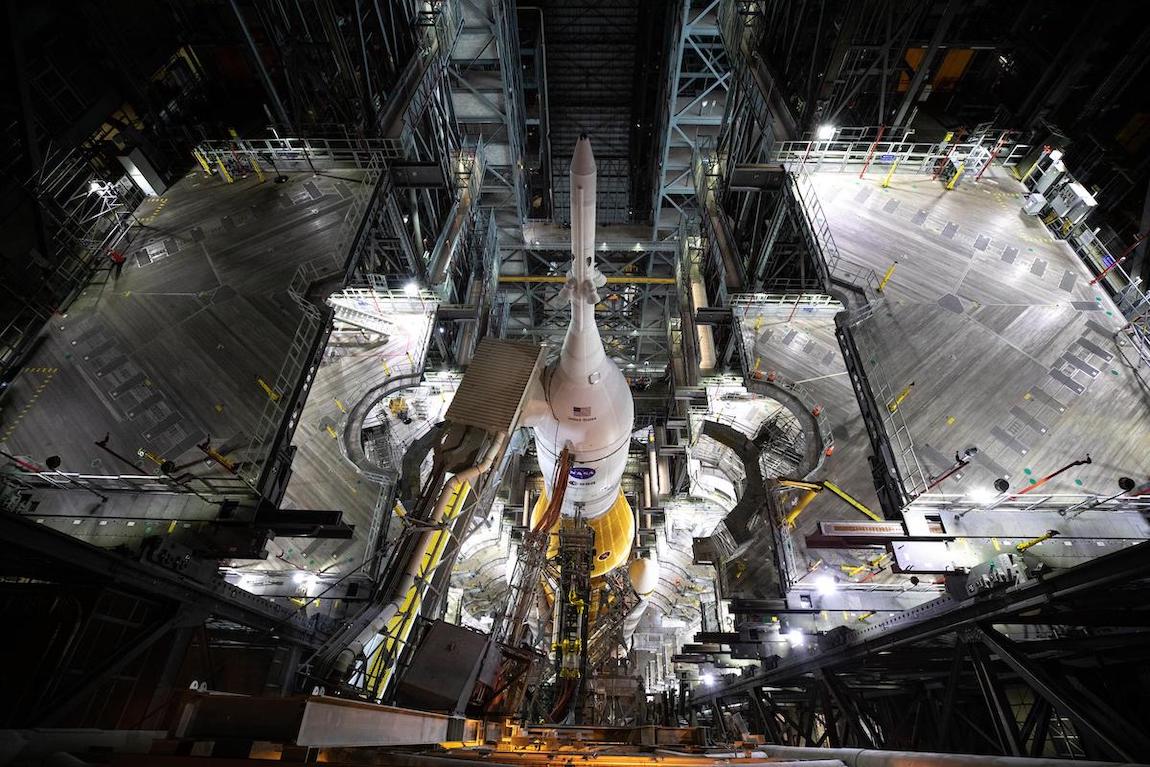Space News & Blog Articles
NASA hopeful about staging fourth moon rocket fueling test in early June
STORY WRITTEN FOR CBS NEWS & USED WITH PERMISSION
 NASA’s Space Launch System moon rocket inside the Vehicle Assembly Building. Credit: NASA/Kim Shiflett
NASA’s Space Launch System moon rocket inside the Vehicle Assembly Building. Credit: NASA/Kim Shiflett
Engineers are making progress resolving mostly ground-system problems that derailed three earlier attempts to fuel the agency’s new Space Launch System moon rocket for a dress rehearsal countdown. NASA managers said Thursday they’re hopeful about making a fourth attempt by mid June.
If all goes well with the next “wet dress rehearsal,” or WDR, countdown test, NASA may be able to press ahead for a long-awaited maiden launch in the August timeframe. But no target dates will be set until after a successful fueling test and the resolution of any other issues that might crop up.
“We’ll set that official launch date after we get through wet dress,” said Jim Free, director of Exploration Systems Development at NASA Headquarters. “But based on some of the historical challenges from similar programs over the years and the performance that we’ve seen thus far, we are looking at a couple launch periods through the August timeframe.”
He said team remains optimistic based on the results of troubleshooting to date.
A jammed valve in the rocket’s second stage has been replaced, the probable cause of a launch platform hydrogen leak has been identified and an off-site vendor is working to complete upgrades to a pipeline system that will deliver enough flame-suppressing gaseous nitrogen to the pad to “safe” the rocket during fueling.
If those issues can be fully resolved, Free said the huge rocket could be hauled back out to pad 39B at the Kennedy Space Center by the end of the month, setting the stage for a fourth fueling test in early to mid June.
After the test, whenever it occurs, the SLS rocket will be moved back to NASA’s Vehicle Assembly Building for servicing before it’s returned to the pad for launch on its maiden flight, sending an unpiloted Orion crew capsule beyond the moon and back.
But Free warned the issues are complex and it’s possible more than one tanking test will be required to thoroughly test the complex systems in the SLS rocket and their interaction with the ground systems that provide propellants, power and other critical elements.
He said the August launch windows would “allow us to do two wet dress rehearsal attempts if we need them.”
“We are optimistic that we only need one more based on everything we’ve been able to do thus far to fine tune our tanking procedures,” he said. “But we also want to be realistic and upfront with you that it may take more than one attempt to get the procedures where we need them.”
Equipped with two extended solid-fuel boosters and a core stage powered by four modified space shuttle main engines, the 322-foot-tall SLS rocket will generate a ground-shaking 8.8 million pounds of thrust at liftoff, more than the legendary Saturn 5 rocket that launched Apollo astronauts to the moon 50 years ago.
The SLS rocket was hauled out to launch pad 39B on March 18, setting the stage for a dress-rehearsal countdown to verify fuel-loading procedures, to practice recycle options and to carry out the myriad other steps required to safely launch the giant rocket.
While the shuttle-heritage technology is familiar, the SLS carries more ultra-cold liquid oxygen and hydrogen propellants — 730,000 gallons — temperatures and pressures are different and the countdown steps to manage the complex systems utilizes new software and procedures.
The wet-dress countdown, or WDR, is intended to test all aspects of the launch system, using the same steps that will be followed on launch day.
Three earlier attempts to load the rocket with propellants were interrupted by a variety of mostly ground-system problems including insufficient gaseous nitrogen, a jammed helium check valve in the rocket’s second stage and the hydrogen leak in an umbilical fitting attached to the first stage.
The helium valve failed to work properly because of a small bit of rubber debris was lodged in the mechanism. The valve has been replaced, but engineers are still trying to determine the source of the debris.
The hydrogen leak apparently resulted from less-than-optimum compression on two seals in a launch platform umbilical. Engineers have tightened those fittings as well as similar fittings in other umbilicals.
While the feed line now appears leak free at room temperatures, engineers won’t know how it performs under ultra-cold cryogenic temperatures until the next attempt to load the SLS with propellants.
When you subscribe to the SpaceZE News Feed, we will send you an e-mail when there are new updates on the site so you wouldn't miss them.

